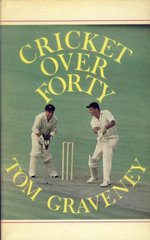Cricket Over Forty
Martin Chandler |Published: 1970
Pages: 160
Author: Graveney, Tom
Publisher: Pelham Books
Rating: 3 stars

Tom Graveney’s cricket career began in 1948, and to all intents and purposes had ended by 1970 when this book was published. By then he was 43 and now, at 84, he is very much one of the elder statesmen of English cricket. I do remember his batting, vaguely, but my main memories of Tom Graveney are as a commentator. Actually his batting made a greater impression because when I asked most of my elders and betters who was the best batsman they had ever seen, while I don’t recall any ever saying “Tom Graveney”, an unusually high number would add, after answering my question, “….but if you want to know who I most enjoyed watching then the answer is Tom Graveney”.
Graveney’s standing was also enhanced in the eyes of this reviewer by his being one of the (in 1970) elite 15 who had scored one hundred centuries. I suppose I had also picked up on the fact that in the late 1960s he had enjoyed a purple patch that brought him, following his recall to the England side at the age of 39, more than 2,000 runs at an average of 63 over the following three years. So although his overall career average does not put him amongst the top tier of Test or First Class batsman (his average was 44.38 in Tests and 44.91 in the First Class game) he was always one of the game’s superstars to me.
As he aged he appeared on radio and television less frequently and then, in 2004, I noticed that he was made President of the MCC, a significant title in the game. By then I knew rather more about him, and later still read a very good biography by Christopher Sandford which made me realise the avuncular Graveney who I recognised must have been a man with a rather different character in his younger days. Reading Cricket Over Forty, which I picked up initially just to look up something about his old adversary Charlie Griffith, served only to reinforce that belief.
In the manner of the times, when top cricketers were paid comparatively poorly, they had a tendency to produce books at regular intervals so, having already given his name to Cricket Through the Covers in 1958 and On Cricket in 1965, this volume does not purport to be a complete autobiography. In fact the first chapter is rather sour in many ways, containing its author’s views on one day cricket, which he considered a necessary evil and the increased physical intensity of the First Class game which was again rather grudgingly accepted as necessary. There is also an introduction to his concerns about his treatment at the hands of Test selectors and the Gloucestershire Club that he left, in acrimonious circumstances, at the end of the 1960 season.
The first half of the book is then made up by the story, a largely happy one, of Graveney’s second coming as a Test match player and looks at the series involved in some detail before the half way point returns to unhappier times, those being the falling out with Gloucestershire, and the final act of his Test career. Graveney was selected for the First match against West Indies in 1969, and scored 75 in his only innings, but following the game the 42 year old was, effectively, banned for three Tests and, at his age, that inevitably spelt the end. What Graveney did that was so heinous was to honour an agreement to play, in return for a substantial amount of money, in a one day game that took place in Luton on the rest day of the Test ? which was played at Old Trafford ? after he had been told not to. Perhaps it is just the passage of time that has changed attitudes but the way that Graveney deals with this suggests that he genuinely expected his reader to sympathise with his plight. Admittedly the 1960s were a very different time, and I did try to make allowances, but simply cannot agree with his perspective on that. His lead-up to the issue did not help a 21st century reader consisting as it did of his complaints about the England tour of Pakistan in 1968/69 and his disappointment at being overlooked for the England captaincy in 1969 in favour of Ray Illingworth. The former were entirely justified but the latter, whilst understandable, does not seem very realistic.
The second half of the book is then a little tedious. It consists of a somewhat bland retrospective on those Graveney had played with and against over his long career, and there is little in the way of revelations about past greats and indeed I suspect little that was fresh even in 1970. In fact I almost put the book down as I neared the end, but I am glad I didn’t. The very last chapter consists of Graveney’s thoughts on batting, and his own approach in particular, something which I have not often seen done with such clarity. It was probably more interesting because my memories of actually watching him bat are confined to my childhood, a time when I had no real interest in technical matters, but what he says remains relevant today.
If truth be told anyone interested in learning more about Tom Graveney would do better to acquire a copy of Sandford’s eponymous biography than hunt down a copy of Cricket Over Forty, but that being said this book is certainly rather better than most of its type.






Leave a comment